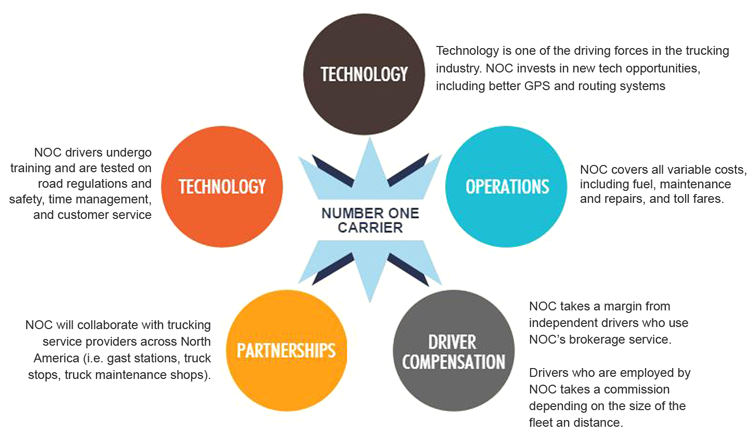FormSwift's 2015 Summer Scholarship asked college students across the country to come up with a sample business plan for one of five categories: Bakery, Restaurant, Salon, Personal Training and Trucking. We chose the best sample business plan for each category, and one scholarship winner.

According to the American Trucking Association, there are about 3 million truck drivers annually in the United States, with the total number of people employed in the industry exceeding 8 million. By 2012, the number of owner operators was 165, 100. This number has since more than doubled to 350,000. Number One Carrier hopes to capture this trend by working closely with owner operators. According to a study conducted by CNBC in 2014, the industry's turnover rate is roughly 92%, which poses a threat to the trucking industry. NOC plans to mitigate the risk by creating the most conductive working environment for drivers through its partnerships and offering competitive compensations.
Customers have numerous operators to choose from in the trucking industry. In order to service large businesses, carriers need several trucks and greater capital investments. Furthermore, having great customer service is important for carrier companies in order to generate repeat business and loyal customers. This is why NOC trains its truck drivers to provide the best quality of servie and aims at having the largest fleet of trucks possible by attracting owner operators and drivers to operate NOC trucks.
The trucking industry in North America is highly competitve due to the presence of numerous operators. Apart from other trucking companies, NOC also faces indirect competition from other forms of transportation, such as air transport. However the demand for trucking companies is growing with for-hire carriers generating $97 billion of the $255 billion in revenue of the entire industry and private fleets generated the remaining $158 billion. Additionally, the average operating ratio is 95.2 cents for every sales dollar. This means that on average, a business operating in the trucking industry generates 4.8 cents in profit for every dollar they earn in revenue.
The presence of an in-house freight brokerage enables truck drivers to receive truckload jobs from our dispatchers in a timely fashion and for the to priority compared to using indepedent brokers. Customers are also assured of their business needs being serviced promptly because freight brokers have permanent drivers they work with, rather than waiting for truckers who are looking for loads.
NOC believes in having a responsibility not only to its customers and employees, but also to the community and environment. NOC champions social responsibiity in the trucking industry by requiring all NOC trucks to be 2008 models or newer, therefore equipped with DP filters (or to be fitted with DP filters) in order to reduce truck emissions and pollution.

Number One Carriers is committed to providing exceptional customer service and the best working environment for its employees. Using the company's stable business model, INdustry knowledge, and experienced management team, NOC strives to gain and maintain market share in the North American trucking industry, while pushing forward to realize growth and return for its investors.
To share this infographic with your readers, embed this in your blog post by pasting the following HTML snippet into your web editor:
Please attribute this infographic to formswift.com/business-plan and Winnie Huang, Marketing Analyst, and Dale Sendagire from Howard University in Washington DC.
![]()
